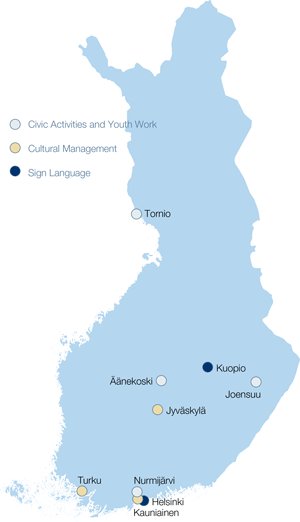HUMAK library - library work in a network organization
13.11.2012

HUMAK is Finland’s smallest University of Applied Sciences that operates as a nationwide network organization. HUMAK’s library is a network of small campus libraries near HUMAK’s campuses around Finland. The basic idea has been to arrange the services in collaboration with the libraries of other institutions. On one hand, the network model poses many challenges for organizing uniform library services on different campuses but on the other, collaboration with other libraries is beneficial.
HUMAK University of Applied Sciences (UAS) operates through a nationwide network with nine campuses around Finland. At the moment, the most southern campus is in Helsinki and the most northern one in the town of Tornio in Lapland, more than 700 km north of the capital. As HUMAK has about 1400 students in total, the campuses are small with about 120-250 students on one campus.
Many of the Finnish UASs have several campuses, but the general principle is to operate on a regional basis or in one city or town and there is only one other UAS in the country that has a nationwide network: Diaconia UAS. Another difference between HUMAK and most other UASs is that HUMAK is not multidisciplinary but specializes in three fields: youth work, arts management and sign language interpreting.
HUMAK library service model
A nationwide network and small campuses pose challenges for arranging the library services. HUMAK’s solution has been collaboration with other organizations and all our libraries also serve other educational institutions or function as special libraries. The foundation for HUMAK’s library structure was laid during the late 1990s when HUMAK was founded, but even after that there have been some minor changes and new forms of collaboration with other libraries. The general aim has been to function in a flexible way and to take into consideration local level needs which may vary from one campus to another.
As all HUMAK campuses operate on the same premises with folk high schools, it has been a natural choice to build shared libraries with these institutions. On five of the campuses, the folk high school is responsible for operating the library and HUMAK buys the services from the folk high school. On two campuses, the roles are reversed and HUMAK operates the library and the folk high school buys the services for their institution. On two campuses there is yet a different solution: in Tornio HUMAK buys the library services from the local university of applied sciences, Kemi-Tornio UAS. And as the Helsinki campus (specializing in sign language interpreting) is located in the same premises as the library for the Finnish Association of the Deaf, this special library also functions as HUMAK campus library. Since 2008, HUMAK library has also cooperated with another special library, the Youth Research Library whose collections are highly relevant to HUMAK’s youth work students.
Even though most of the librarians working in the HUMAK library network are not directly employed by HUMAK, the librarians meet up regularly. These meetings, our e-mailing list and the library’s internal Google site are among the communication tools that we use to discuss and develop our services.
The benefits and challenges of library work in a network
In most HUMAK campus libraries, the collections of the different institutions the library serves support one another. Especially the collaboration with special libraries is beneficial from the viewpoint of collections as the special libraries’ in-depth collections in their own field are also available for HUMAK’s staff and students. As the students get to know a special library in their field already during their studies, they will know where to turn to if they need a special library later on when working as professionals in their own field.
The network model naturally poses many challenges for the services. The libraries are small and mostly run by just one staff member who may also have other professional duties than library work. For the staff it is not possible to specialize as much as in bigger libraries. Then again, in a small library it is easy for the staff to get to know the library customers and thus give tailored library services for both students and staff.
As all the libraries serve more than one institution, the libraries cannot be profiled or marketed to one user group only. For example, as HUMAK’s electronic resources are only available to HUMAK patrons and not to users coming from other institutions this needs to be taken into consideration at the local level when promoting these services. In many practical details it is not possible to be completely uniform in all campuses, for example there is some variation in loan periods and opening hours. Finding a balance between equal quality of services throughout the network and flexibility in adapting to local situations is not always straightforward.
Future changes in HUMAK libraries
As many other Finnish Universities of Applied Sciences, HUMAK is also facing many changes during the following years due to government cuts in education. HUMAK will continue as a network organization with campuses around Finland, but the number of campuses will be reduced and the remaining campuses will have a bigger student intake than at the moment. These changes naturally also affect the library. In fact, basically the whole library service model needs to be revalued. At the moment there still are more questions than answers as the revaluation process has just started, but the academic year 2012-2013 will hopefully bring answers to most questions.
Artikkelin tiedot
Kirjoittaja: HUMAK Pirjo Kangas Information specialist
Numero: 2

Kommentit